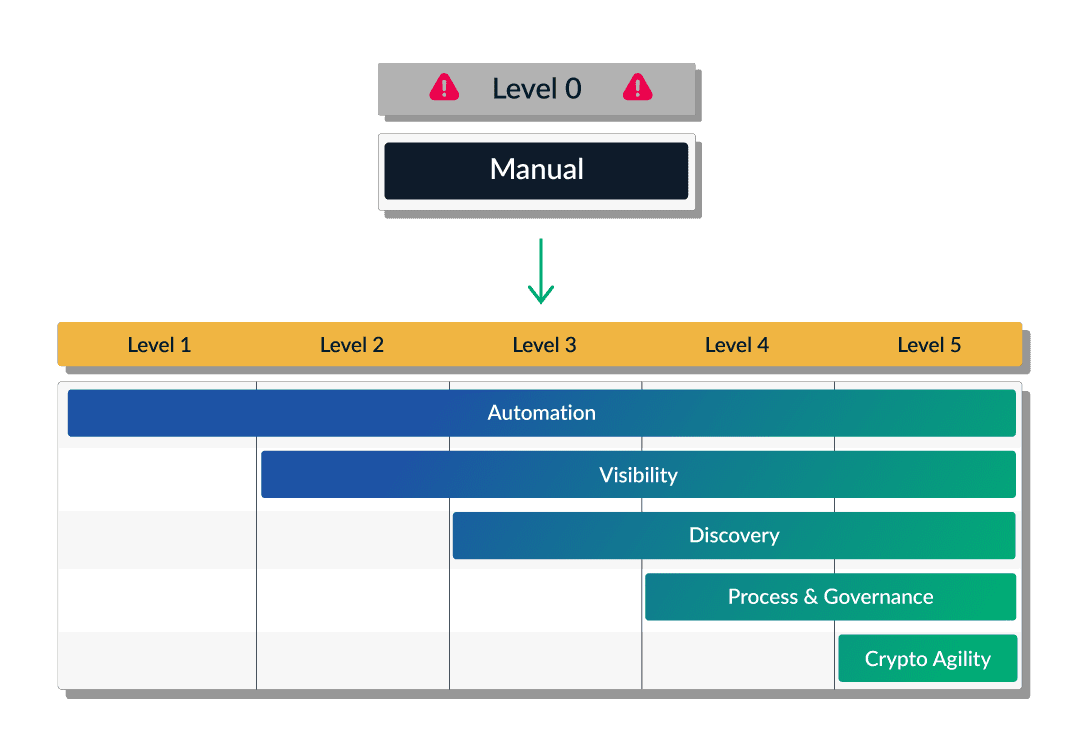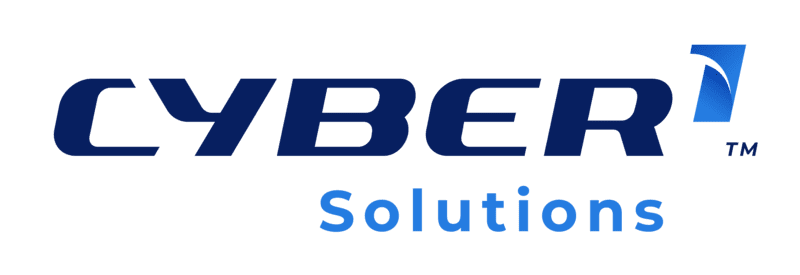Automated certificate lifecycle management (CLM) simplifies the complex process of managing SSL/TLS certificates, enhancing efficiency and security for businesses. As digital certificates become harder to deploy and renew manually, Sectigo’s CLM maturity model provides a framework to guide organizations at different stages of automation. It helps businesses efficiently manage their certificate needs, ensuring smoother operations and stronger security. Automation is key, but the right strategy depends on the specific needs of each business.
Table of Contents
Digital certificates provide much-needed encryption and authentication to safeguard web-based interactions and build a foundation of trust. Unfortunately, SSL/TLS certificates can be difficult to deploy and track, especially given the accelerating pace of renewals.
Automated certificate lifecycle management (CLM) promises to bring greater structure and efficiency to digital certificate discovery, deployment, renewal, and even revocation. Increasingly, however, the question is not whether businesses need to adopt an automated CLM platform, but how this process should play out.
These days, automated certificate lifecycle management is largely viewed as indispensable. While SSL/TLS certificates safeguard sensitive information and facilitate trust, they can be complicated to manage, especially for businesses and enterprises that have hundreds or even thousands of them in use. That being said, automation takes many forms, and strategies that may prove sufficient for some organizations may not be comprehensive enough for others.
This is where the concept of CLM maturity proves so valuable. Offering a powerful framework for adopting and maintaining automated solutions, Sectigo’s CLM maturity model is a highly valuable resource for businesses and enterprises of all types and sizes — including both CLM novices and experienced IT teams looking to up their game.
This should not be confused with the other CLM: contract lifecycle management. This involves making and managing agreements with clients or vendors — and as with certificate-based management, this process may evolve as businesses grow. Automation is crucial to both types of CLM maturity, but it takes different forms and involves dramatically different technical procedures and compliance concerns.
No matter how you envision CLM maturity, it is important to keep abreast of developments surrounding digital certificates and the overarching cybersecurity ecosystem. A detailed CLM maturity model can guide this process. Keep reading to learn about the five levels of Sectigo’s CLM maturity model and how these various levels influence long-term certificate management.
Understanding the CLM maturity model
Sectigo has developed a unique maturity model that highlights various stages that most enterprises will navigate on the path to automated certificate lifecycle management.
Each journey will look a bit different, but often, enterprises begin with manual processes and eventually pursue robust, safer solutions designed to streamline critical management processes and provide maximum protection.
Sectigo’s model aims to not only describe various stages that enterprises tend to navigate, but also, to aid in assessments that reveal how much progress specific businesses have achieved — and what steps they can realistically take to elevate their CLM strategy.
CLM maturity may mean different things to different organizations, but it often involves a fully automated process that provides maximum flexibility, seamless integrations, and strong compliance.
Levels of CLM maturity
There is no simple path to CLM maturity. This journey reflects various industry standards, technology integrations, and other complications. Structure is important, however, and with a few basic parameters in place, it should quickly become evident where various enterprises stand and where they need to improve.
When conducting assessments or developing objectives, Sectigo typically references a few basic categories. Referred to as “levels” to highlight a desired sense of forward momentum, these designations can reveal a lot about how CLMs function and how their core beliefs or overarching objectives influence every aspect of certificate management.
Check out these descriptions to get a better sense of which level your business may currently occupy and how this progress relates to concerns such as crypto agility and shorter SSL certificate validity periods.

A graphic showing five levels of CLM maturity, from manual processes at Level 0 to crypto agility at Level 5.
Level 0: Manual
For years, many enterprises have stuck with the digital certificate status quo: manual strategies and minimal structure. With these businesses, certificate processes such as renewal and revocation seem almost haphazard.
This approach is understandable when viewed through the lens of today’s struggling small business owners: those with limited technical skills may mistakenly assume that the process of deploying, tracking, and renewing certificates is straightforward and easily handled internally. Some business owners feel overwhelmed at the prospect of researching and implementing automated CLM solutions.
Unfortunately, these organizations are the most prone to outages due to forgotten or overlooked certificate renewals. Small IT departments may be stretched too thin, creating security vulnerabilities that can lead to costly lapses and data breaches. What’s more, these enterprises will be incredibly vulnerable moving forward, as 45-day certificate lifespans will soon expose weaknesses within CLM processes that may have seemed sufficient when the maximum validity period reached 398 days.
Level 1: Automation
In recent years, many business leaders and IT experts have realized that manual CLM strategies are problematic. Perhaps they’ve suffered one outage too many, observed escalating costs, or are concerned about further inefficiencies as the new normal for the SSL certificate lifespan moves to a mere 45 days. No matter the reasons for this shift, it becomes clear that automated digital certificate management solutions are necessary.
Enter CLM maturity level 1. This involves the initial introduction of automation, which can streamline essential processes ranging from certificate issuance to renewals and even revocation.
The importance of this shift cannot be overstated, and, for many businesses, ascending to level 1 requires the most significant adjustments. These changes go beyond shifting processes and strategies to encompass a whole new mindset regarding the certificate lifecycle.
Automation can be transformative — but on its own, it may also prove limited. Despite automating, leaders or IT staff members may struggle with disjointed operations or a simple lack of understanding.
Level 2: Automation and visibility
Although automation represents an exciting step forward, it, alone, will not entirely remove the risk of certificate errors or expirations. Visibility is essential because it produces a comprehensive understanding of all digital certificates, ensuring that each is accounted for and managed appropriately throughout their lifecycle.
There are many ways to boost visibility, but often, this involves continuous tracking and real-time notifications. When both strategies enter the picture, it should become abundantly clear how certificates function and when renewals are required. A single interface makes this extensive information easier to follow and understand, but automation ensures that key certificate processes remain as efficient as possible.
Automation and visibility represent a powerful combination, but for some businesses, level 2 does not go far enough. It can be difficult to achieve full visibility when high-level discovery strategies are lacking. By moving to level 3, businesses can truly live out the promises of level 2.
Level 3: Automation, visibility, and discovery
Real-time notifications can enhance visibility for newly deployed certificates, but it takes a lot to achieve full oversight in a vast digital landscape that may encompass many certificate authorities (CAs). This is where discovery plays a crucial role. Certificate discovery is an essential aspect of visibility because, as our experts at Sectigo commonly explain, “You cannot manage what you cannot see.”
Certificate discovery enhances visibility by taking inventory of all certificates — their expiration dates, security standards, and CAs. This ensures that all certificates are known — an essential for maintaining maximum security and agility.
By automating discovery, enterprises can gain comprehensive oversight that extends across all certificates and through all stages in the certificate lifecycle. Larger organizations tend to occupy this level, as will some smaller or midsize businesses in highly regulated industries.
If there is a downside to this level (other than the initial expenses that accompany implementation), it is the potential for bottlenecks, especially as they relate to limited integrations. By advancing to level 4, enterprises can further improve their security posture while achieving seamless, end-to-end automation.
Level 4: Automation, visibility, discovery, and process & governance
Featuring robust monitoring, level 4 gives organizations the tools and procedures needed to achieve strong compliance. While automation, visibility, and discovery can certainly help organizations adhere to stringent standards, policy-driven strategies bring greater confidence.
This should be accompanied by robust integrations, including support for the Automated Certificate Management Environment (ACME) protocol, the Simple Certificate Enrollment Protocol (SCEP), and the Representational State Transfer Application Programming Interface (REST API)/
Level 4 meets a wide range of organizational requirements today, but may not be fully equipped to continue providing optimal security in the future. Forward-thinking leaders who want to prepare for the cybersecurity challenges of tomorrow, especially with advancements in quantum computing on the horizon, will be drawn to the next level which emphasizes crypto-agility and long-term security.
Level 5: Automation, visibility, discovery, process & governance, and crypto agility
Reaching Level 5 represents the pinnacle of CLM maturity, with a focus on achieving crypto agility that prepares organizations for both current and future cryptographic challenges. While today, enterprises in highly regulated industries or those pursuing cutting-edge solutions are most likely to be at this level, all organizations should be working toward Level 5, particularly in preparation for the advent of post-quantum encryption. This level shifts the conversation away from what works now and, instead, emphasizes the need to adapt alongside the quickly changing digital landscape.
At Level 5, organizations are equipped to swiftly and seamlessly adjust cryptographic algorithms, including adopting quantum-resistant cryptographic methods as quantum computing evolves and deems existing algorithms ineffective. If an organization has fully achieved Level 4 across the board, they’ve already reached Level 5 of CLM maturity. Additionally, those using solutions like Sectigo already have the necessary robust Public Key Infrastructure (PKI) in place, ensuring readiness for the transition to new cryptographic methods when needed.
CLM maturity assessment for businesses
Certificate lifecycle management represents more than a simple series of technological tasks. Ideally, this will involve a shift in mindset, moving towards crypto-agility and an organizational culture of security. It takes time and effort to make this shift, and upfront costs can be expected as new systems are implemented and integrations navigated.
A CLM maturity assessment can remove some of the burden from this process, offering a clear roadmap for achieving automated certificate lifecycle management and even crypto agility. This thorough evaluation provides a deep dive into current processes, including strengths and weaknesses, plus opportunities for improvement. Results are compared to a detailed maturity model, revealing which objectives are most realistic and attainable.
Streamline CLM maturity levels with Sectigo
As you upgrade your CLM, embrace a strategic mindset — and make the most of the many tools and resources offered by our team at Sectigo. To learn more about CLM maturity — and the process of achieving it — check out our ebook. Next, discover how Sectigo’s Certificate Manager can remove the guesswork from automated certificate lifecycle management.








